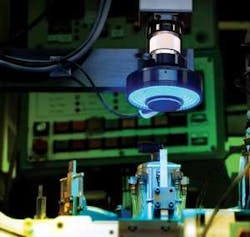Lean customer staffing opens opportunities for system integrators
A discussion with David Dechow of aptúra Machine Vision Solutions
VSD: What is aptúra’s role in designing vision systems for end users?
Dechow: We provide turnkey machine-vision solutions and engineering support over a wide range of machine-vision technologies, covering a broad scope of industrial applications. Machine vision has been evolving over the past several years, both as a technology and as a market. Components for use in integrated solutions are continually becoming easier to use and understand for the plant floor engineer. At the same time, corporations that seek to apply machine-vision technology have reduced their engineering staff and become leaner. As a result, it is rare to find an end-user company with a true “machine-vision guru” or even a champion for the technology.
This engineering resource gap has made the need for competent machine-vision integrators greater than ever. Years ago, companies sought out integrators for machine-vision projects primarily because it took a specialist to apply the technology. Today, companies think that they may be able to apply the technology themselves but regularly find that they need to outsource machine-vision projects because of available-technical-resource limits.
We help our customers-typically end users or industrial automation suppliers-understand the requirements of their application, prepare detailed specifications, design and build the integrated system, and deliver and install a turnkey inspection system. And we provide a complete system warranty for all of our installations, fully guaranteeing that the customer’s application performs to specification.
VSD: How do you approach a new application? Do you work with OEMs or other system integrators?
Dechow: I’m a firm believer in up-front application specification. When a machine-vision application has problems, it’s usually because of a lack of specification and clear project direction. We always start by helping the customer develop a realistic specification that encompasses all (or most) of their inspection requirements. Armed with a mutually acceptable specification, we can competently provide a proposal for a system that meets the inspection criteria, and then address cost justification and implementation issues.
With cheaper and easier-to-use machine-vision components, the barriers for entry to become a machine-vision integrator have diminished significantly. What has not diminished is the risk associated with a machine-vision application. aptúra is positioned to act as an expert engineering resource not only for end-users, but also for OEM’s and other systems integrators who seek to reduce risk on a specific, challenging machine-vision application. The key here is that we specialize exclusively in machine-vision systems and integration. By not competing for non-machine-vision automation applications, we can effectively partner with and serve that OEM sector of the market.
VSD: What are users demanding from you in the design of new systems?
Dechow: User expectations and demands have been shaped over the past several years by highly successful marketing campaigns undertaken by the key manufacturers of machine-vision components. Just a few years ago, the typical comment from an engineer considering machine vision was that he/she was worried about the technology because of its track record for poor performance. Thanks in large part to marketing efforts, a frequently held user point of view is that “machine vision didn’t work well before, but in the past five-to-six years all of that has been fixed, and it should be no problem to inspect anything.”
Generally, user expectations are that machine-vision technology capabilities have grown significantly, while prices continue to plummet. Reality, of course, is a little less dramatic than that. We constantly are educating the customer base about the true capabilities of today’s machine-vision components so that they can understand what applications and inspections can be achieved with a realistic expectation of success.
User system requirements also go beyond the inspection itself. While smart sensor and smart camera manufacturers have promoted and implemented a stand-alone, distributed inspection model, many customers still demand a centralized, custom user interface with widely varying data gathering, reporting, and archiving capabilities. The basic development environments of many products do not provide the extent of interface capabilities often requested, and the applications often require further application design and integration.
VSD: What technologies and components does aptúra use in these applications?
Dechow: We essentially are a job shop for machine-vision applications. In more than 80% of our projects, the customer has specified which major component it would like us to evaluate and quote. Of course, it is up to us to determine whether the targeted product is appropriate for the application and whether or not we can guarantee a successful result. To fully serve our customers, we maintain a high level of expertise in all of the leading components and technologies, including advances and new products in peripherals such as lighting and optics. The types of components we use span virtually all machine-vision products, including smart cameras and vision processors, software libraries, digital camera interfaces, LED lighting, and optics.
VSD: How is each OEM component more or less important for the applications that you serve?
Dechow: As much as machine-vision technology progresses, the adage that was true 20 years ago remains true today: lighting and optics contribute 80% or more to the success of a machine-vision application. While there certainly are differing levels of capability, features, and algorithms in machine-vision processors and smart cameras, the ultimate performance of a machine-vision application is nearly always dependent upon the quality of the image. For me, this makes lighting and optics the most important components in any machine-vision application. And along with lighting and optics issues, one must remember to consider part presentation as part of the imaging chain. Part location variation can wreak havoc on a lighting design.
Of course, anyone integrating machine vision must make decisions about which smart camera, machine-vision processor, or software library to use. These components are important to the application but sometimes might be selected based upon more subjective criteria. In some cases for example, closely competing components might have very similar capabilities and performance relative to the target application. For these applications, component choices might be made based on things like customer preference or operator interface requirements rather than processing capabilities.
Conversely, it’s important to keep in mind that all products are not equal, and not every machine-vision component is capable of performing all applications. In the world of smart sensors, smart cameras, embedded processors, and PC-based software libraries we see a very diverse set of product offerings and system architectures, each with discernable strengths and weaknesses. Along with bad imaging, another sure way to make a machine-vision application more difficult is to select a processing platform whose algorithms, architecture, or general capabilities do not match the target application.
VSD: What could vision equipment manufacturers do to make your implementation jobs easier?
Dechow: I have a friend in medicine who tells me that “doctors make the worst patients.” In the machine-vision industry, some manufacturers might say that integrators make the worst customers. I hear that integrators are sometimes perceived by manufacturers as having the most complaints about the product, and as requiring the most support.
I don’t look to the equipment manufacturer to make our job easier technically. The value of an integration company should be that it has the expertise to implement the component with a minimum of involvement from the manufacturer. In fact, I think that the integrator should have technical expertise--particularly applications knowledge--that exceeds that of the component manufacturer. The manufacturer should expect to train their integration channel partners well, and then be able to concentrate support resources on end-users. As an integrator, we do like to have access to very high levels of technical support, but we expect to use that support sparingly only for the most difficult questions.
VSD: How do you envision the future of imaging in the industries you serve? What kinds of new applications do you expect to emerge? In which areas do you see the most growth?
Dechow: Our industry has barely scratched the surface in implementing machine vision in industrial automation applications. While the push is on by component manufacturers to capture a share of “emerging” vision markets, such as security automation and medical/scientific imaging, the core business of industrial automation must not be ignored and will continue to grow. Demands for production efficiency and quality in the automotive, electronics, packaging, and food and beverage industries will continue to fuel the need for a variety of machine-vision applications, even in the face of temporarily stagnant capital asset purchases.
New application areas will be driven more by component costs and technological capability than market demand. In industrial applications for example, both color and 3-D applications continue to show promise if component costs and algorithm capabilities become competitive with gray-scale 2-D technology.
I don’t see on the horizon some new machine-vision application area that singularly will spur major growth in the industry. Rather, I consider application-specific turnkey systems integration and engineering support to be one of the major growth areas within the machine-vision marketplace.
VSD: How will OEM components targeted toward machine-vision applications have to change to meet the future needs of system integrators?
Dechow: In general, the experienced machine-vision integrator will benefit from a more open system architecture. Our ability to manipulate operator interfaces and even inspection algorithms means that we deliver a more reliable and targeted system to the end user. Of course, this kind of customization is inherent in PC-based systems. But it also can be achieved with smart-camera components, given that the manufacturer provides the software layers that will allow levels of custom development.
DAVID DECHOW is president and founder of aptúra Machine Vision Solutions. He previously founded Insight Integration and has served as president of the Automated Imaging Association. Editor in chief Conard Holton talked to him about designing vision systems to meet customer requirements.
Smart camera checks electronics
A machine-vision system, designed and integrated by aptúra Machine Vision Solutions, was installed on existing automation equipment. The system inspects electronic components at 10 parts/sec, detecting surface and molding flaws and performing optical character verification to ensure the readability of laser-etched part identification.
The blue CCS (Waltham, MA, USA; www.ccsamerica.com) LED strobe light was chosen because it creates a high contrast between the print and part-body color. A PPT Vision (Eden Prairie, MN, USA; www.pptvision.com) intelligent camera provides a cost-effective and efficient processing platform, with minimal physical impact to the existing machine layout. An LCD flat-panel touch-screen display (not shown) provides a custom graphical user interface for process feedback and operator interaction. Good parts continue to a packaging process. The inspection helps the manufacturer verify specifications and attain quality PPM required by key customers.


